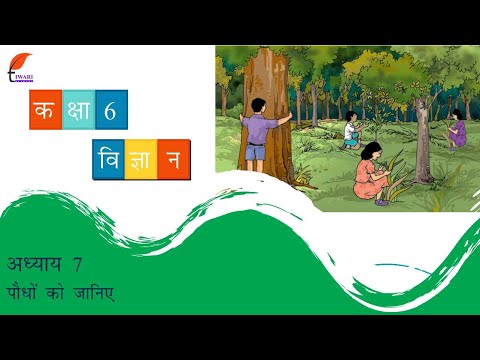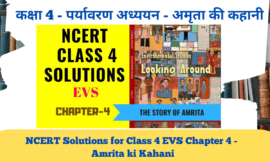NCERT Solutions for Class 6 Science Chapter 7
कक्षा 6 विज्ञान अध्याय 7 पौधों को जानना
अध्याय 7 अभ्यास प्रश्न
1. निम्नलिखित कथनों को शुद्ध कीजिए और उन्हें अपनी नोटबुक में पुनः लिखिए।
(ए) तना मिट्टी से पानी और खनिजों को अवशोषित करता है।
(b) पत्तियाँ पौधे को सीधा रखती हैं।
(c) जड़ें पत्तियों तक जल पहुँचाती हैं।
(d) एक फूल में पंखुड़ियों और पुंकेसर की संख्या हमेशा बराबर होती है।
(ङ) यदि किसी पुष्प की बाह्यदलें आपस में जुड़ जाती हैं तो उसकी पंखुड़ियाँ भी आपस में जुड़ जाती हैं।
(च) यदि एक फूल की पंखुड़ियाँ आपस में जुड़ जाती हैं, तो स्त्रीकेसर पंखुड़ी से जुड़ जाता है।
हल:
a) जड़ें मिट्टी से पानी और खनिजों को अवशोषित करती हैं।
ख) तना पौधे को सीधा रखता है।
c) तना पत्तियों तक पानी पहुँचाता है।
घ) एक फूल में पंखुड़ियों और पुंकेसर की संख्या हमेशा समान नहीं हो सकती है।
ङ) यदि किसी पुष्प के बाह्यदलों को आपस में जोड़ दिया जाए तो उसकी पंखुड़ियां अलग-अलग हो जाती हैं।
च) यदि किसी फूल की पंखुड़ियाँ आपस में जुड़ी हुई हैं, तो स्त्रीकेसर पंखुड़ी से जुड़ा हो सकता है या नहीं भी हो सकता है।
2. (क) एक पत्ती, (ख) एक मूसला जड़ और (ग) एक फूल का चित्र बनाइए जिसका अध्ययन आपने सारणी 7.3 में किया है।
हल:
एक)
बी)
सी)
3. क्या आप अपने घर में या अपने आस-पड़ोस में ऐसा कोई पौधा पाते हैं जिसका तना लंबा लेकिन कमजोर हो? इसका नाम लिखिए। आप इसे किस श्रेणी में रखेंगे?
हल:
जी हां, लौकी के पौधे को सहारे की जरूरत होती है। यह एक पर्वतारोही है।
4. तने का क्या कार्य है?
हल:
तने के निम्नलिखित कार्य हैं
- तने पौधे को सीधा रखते हैं।
- तना पत्तियों तक पानी पहुँचाता है।
- तने भोजन को पत्तियों से पौधे के अन्य भागों तक पहुँचाते हैं।
5. निम्नलिखित में से किन पत्तियों में जालीदार शिराविन्यास होता है?
गेहूं, तुलसी, मक्का, घास, धनिया (धनिया), चीन गुलाब
हल:
तुलसी, चाइना रोज और धनिया में जालीदार शिरा विन्यास होता है।
6. यदि किसी पौधे की जड़ें रेशेदार होती हैं, तो उसकी पत्तियों में किस प्रकार का शिरा विन्यास होता है?
हल:
यदि किसी पौधे की जड़ रेशेदार होती है, तो उसकी पत्तियों में समानांतर शिरा विन्यास होता है।
7. यदि किसी पौधे की पत्तियाँ जालीदार शिराविन्यास वाली हों, तो उसकी जड़ें किस प्रकार की होंगी?
हल:
यदि किसी पौधे की पत्तियाँ जालीदार शिराविन्यास वाली होती हैं, तो उसमें मूसला जड़ होगी।
8. क्या आपके लिए यह पता लगाना संभव है कि कागज की शीट पर इसकी पत्ती की छाप देखकर पौधे की मूसला जड़ या रेशेदार जड़ें होती हैं?
हल:
हाँ, यह पता लगाना संभव है कि किसी पौधे की मूसला जड़ है या रेशेदार जड़, कागज़ पर उसकी पत्ती की छाप देखकर।
9. फूल के कौन से भाग होते हैं?
हल:
ए) सेपल्स
बी) पंखुड़ी
ग) पुंकेसर
घ) स्त्रीकेसर
10. निम्नलिखित पौधों में से किसमें फूल होते हैं?
घास, मक्का, गेहूं, मिर्च, टमाटर, तुलसी, पीपल, शीशम, बरगद, आम, जामुन, अमरूद, अनार, पपीता, केला, नींबू, गन्ना, आलू, मूंगफली
हल:
फूल वाले पौधों में घास, मक्का, गेहूँ, मिर्च, टमाटर, तुलसी, पीपल, शीशम, बरगद, आम, जामुन, अमरूद, अनार, पपीता, केला, नींबू, गन्ना, आलू, मूंगफली शामिल हैं।
11. पौधे के उस भाग का नाम लिखिए जो भोजन उत्पन्न करता है। प्रक्रिया का नाम बताइए।
हल:
पत्तियाँ प्रकाश संश्लेषण नामक प्रक्रिया द्वारा भोजन का निर्माण करती हैं।
12. पुष्प के किस भाग में अंडाशय मिलेगा?
हल:
अंडाशय स्त्रीकेसर के सबसे निचले और सबसे सूजे हुए भाग में पाया जाता है।
13. ऐसे दो पौधों के नाम लिखिए जिनमें एक में बाह्यदल जुड़े हों तथा दूसरे में अलग-अलग बाह्यदल हों।
हल:
संयुक्त बाह्यदल वाले पौधे – धतूरा और कपास
अलग-अलग बाह्यदल वाले पौधे – गुलाब और कमल
NCERT Solutions for Class 6 Science Chapter 7 Getting to Know Plants
Chapter 7 Exercise Questions
1. Correct the following statements and rewrite them in your notebook.
(a) Stem absorbs water and minerals from the soil.
(b) Leaves hold the plant upright.
(c) Roots conduct water to the leaves.
(d) The number of petals and stamens in a flower is always equal.
(e) If the sepals of a flower are joined together, its petals are also joined together.
(f) If the petals of a flower are joined together, then the pistil is joined to the petal.
Solution:
a) Roots absorb water and minerals from the soil.
b) Stem holds the plant upright.
c) Stems conduct water to the leaves.
d) The number of petals and stamens in a flower may not always be equal.
e) If the sepals of a flower are joined together, its petals are separate.
f) If the petals of a flower are joined together, then the pistil may or may not be joined to the petal.
2. Draw (a) a leaf, (b) a taproot and (c) a flower you have studied for Table 7.3
Solution:
a)
b)
c)
3. Can you find a plant in your house or in your neighborhood which has a long but weak stem? Write its name. In which category will you place it?
Solution:
Yes, lauki (gourd) plant needs support. It is a climber.
4. What is the function of a stem?
Solution:
Following are the functions of a stem
- Stems hold the plant upright.
- Stems conduct water to the leaves.
- Stems conduct food from leaves to other parts of the plant.
5. Which of the following leaves have reticulate venation?
Wheat, tulsi, maize, grass, coriander (dhania), China rose
Solution:
Tulsi, China rose, and coriander have reticulate venation.
6. If a plant has fibrous roots, what type of venation do its leaves have?
Solution:
If a plant has a fibrous root, its leaves have parallel venation.
7. If a plant has leaves with reticulate venation, what kind of roots will it have?
Solution:
If a plant has leaves with reticulate venation, it will have a tap root.
8. Is it possible for you to find out whether a plant has taproot or fibrous roots by looking at the impression of its leaf on a sheet of paper?
Solution:
Yes, it is possible to find whether a plant has taproot or fibrous roots by looking at the impression of its leaf on a sheet of paper.
9. What are the parts of a flower?
Solution:
a) Sepals
b) Petals
c) Stamens
d) Pistil
10. From the following plants, which of them have flowers?
Grass, maize, wheat, chilli, tomato, tulsi, peepal, shisham, banyan, mango, jamun, guava, pomegranate, papaya, banana, lemon, sugarcane, potato, groundnut
Solution:
The plants which have flowers are grass, maize, wheat, chilli, tomato, tulsi, peepal, shisham, banyan (flowers lie inside its fruits), mango, jamun, guava, Pomegranate, papaya, banana, lemon, sugarcane, potato, groundnut
11. Name the part of a plant which produces food. Name the process.
Solution:
Leaves produce food through a process called Photosynthesis.
12. In which part of a flower will you find the ovary?
Solution:
The ovary is found in the lowermost and most swollen part of the pistil.
13. Name two plants in which one has joined sepals, and the other has separate sepals.
Solution:
Plants with joined sepals – Datura and cotton
Plants with separate sepals – Rose and Lotus



